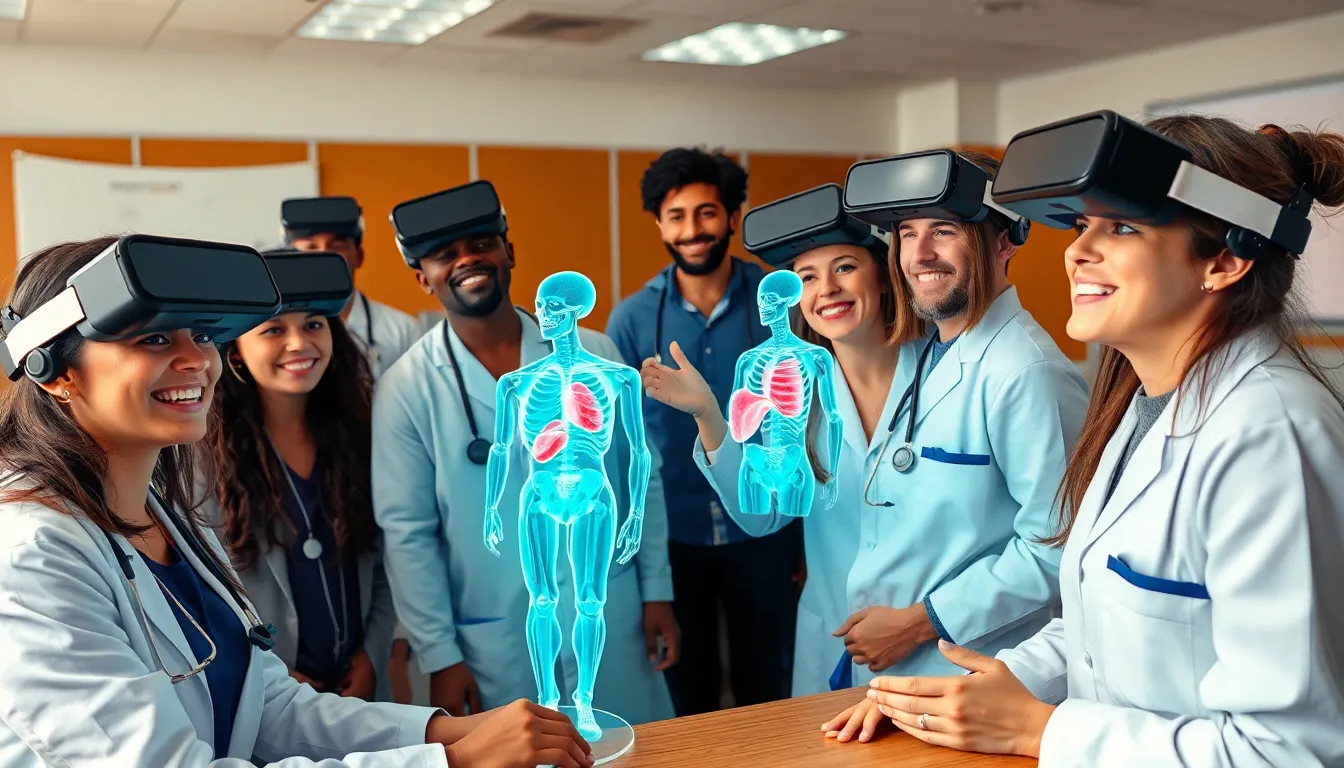Imagine walking into a doctor’s office and instead of staring at outdated posters of anatomy, you’re greeted by a holographic heart doing the cha-cha. Welcome to the world of AR healthcare, where augmented reality transforms the way patients and doctors interact. It’s not just sci-fi anymore; it’s a revolutionary approach that brings medical training and patient care into the 21st century.
Table of Contents
ToggleOverview of AR Healthcare
Augmented reality (AR) in healthcare revolutionizes patient and doctor interactions by creating immersive experiences. This technology enables medical professionals to visualize complex anatomy and pathology in 3D. Educational purposes benefit significantly from AR, as it allows for interactive training modules for medical students and healthcare providers. Holograms can display organs and structures in real time, enhancing understanding and retention of information.
Patient engagement improves as well; AR tools facilitate communication by providing visual aids that clarify medical conditions. Medical imaging integrates seamlessly with AR, allowing specialists to overlay diagnostic images directly onto patients during procedures. Enhanced surgical precision emerges from AR applications, where surgeons visualize crucial landmarks and anatomy layers through head-mounted displays.
Telemedicine adopts AR for remote consultations, enabling specialists to guide procedures from different locations. Real-time assistance enhances healthcare delivery, supporting field practitioners in emergency situations. With AR, rehabilitation exercises become more interactive, motivating patients through gamified experiences.
Statistics show that AR adoption in healthcare increased by 100% from 2016 to 2021. Its applications span diagnostics, surgical training, treatment planning, and patient education, indicating a growing trend towards digitization and innovation. Major healthcare institutions invest heavily in AR solutions, contributing to advancements that improve patient outcomes.
Global projections estimate that the AR in healthcare market will reach $7 billion by 2026, driven by increasing demand for advanced medical technologies. This shift reveals a commitment to enhancing the quality of care and ensuring better diagnostic accuracy. By integrating AR into healthcare, the industry steps closer to a future where technology significantly augments human capabilities.
Benefits of AR in Healthcare

Augmented reality (AR) offers numerous advantages in healthcare, transforming training and patient interactions significantly.
Enhanced Medical Training
Interactive training modules utilize AR technology to provide realistic simulations for medical students. Visualizing complex anatomical structures in 3D enhances understanding and retention of critical information. These immersive experiences allow learners to practice procedures in a safe environment without risk to patients. Universities and medical institutions increasingly incorporate AR into curriculums to prepare future healthcare professionals more effectively. Collaboration among students becomes easier, fostering teamwork skills essential in clinical settings. Studies show that AR in medical training boosts engagement by 40%, indicating its growing importance in education.
Improved Patient Care
AR tools help clarify medical conditions through engaging visual aids. Patients gain a better understanding of their diagnoses when medical professionals use 3D representations of organs or tissues. During treatments, specialists can overlay diagnostic images directly onto patients for more accurate procedures. Enhanced visualization directly contributes to higher satisfaction rates, as it personalizes the patient experience. Telemedicine also leverages AR for remote consultations, making it easier for specialists to provide guidance and support. Improved communication fosters trust between patients and healthcare providers, vital for effective care strategies.
Applications of AR Healthcare
Augmented reality in healthcare offers numerous applications that enhance patient care and medical training.
Surgical Assistance
Surgical procedures benefit significantly from AR technology. Surgeons visualize 3D overlays of patient anatomy during operations, improving accuracy. Enhanced imaging leads to better decision-making and minimizes potential errors. As studies show, AR improves surgical outcomes and reduces recovery times. Additionally, real-time data can guide surgical tools, making complex procedures more manageable. Surgeons adopt AR systems for precise interventions, making the technology essential in operating rooms. This innovative approach fosters higher patient satisfaction, contributing to overall improved healthcare services.
Patient Education
AR tools facilitate patient education through interactive visual aids. Patients gain a clearer understanding of their conditions with 3D representations of organs and tissues. Engaging demonstrations enhance information retention, leading to better health decisions. Medical professionals utilize AR to explain diagnoses more effectively, fostering informed consent. As a result, patients report greater satisfaction and confidence in their healthcare journeys. Statistics indicate that enhanced visualization correlates with improved health literacy. Ultimately, AR transforms patient education from traditional methods to immersive learning experiences, enriching the doctor-patient relationship.
Challenges and Limitations
Challenges persist in the integration of augmented reality in healthcare, impacting its widespread adoption.
Technical Barriers
Technical barriers hinder the effectiveness of AR technology in clinical settings. High costs of AR devices and software pose significant hurdles for healthcare facilities. Inadequate infrastructure also contributes to poor user experiences, as connectivity issues can disrupt the functionality of AR applications. Additionally, a lack of standardized protocols for AR use leads to inconsistent implementation across different institutions. Training healthcare professionals to use AR effectively requires time and resources, which some organizations may lack. Technical support also remains limited, complicating troubleshooting efforts and maintenance of AR systems.
Regulation and Compliance
Regulatory challenges complicate AR’s integration into healthcare. Approval processes for AR devices demand extensive testing and validation, which can slow down the introduction of innovations. Compliance with healthcare regulations such as HIPAA is crucial for maintaining patient privacy. AR solutions often need to secure patient data, adding another layer of complexity. Ensuring interoperability with existing medical systems often proves challenging, as AR technologies must align with established medical software. Ultimately, navigating these regulatory landscapes requires substantial effort from developers and healthcare organizations alike.
Future of AR Healthcare
Augmented reality (AR) is set to redefine healthcare practices in the coming years. Enhancing patient care and medical training sits at the forefront of AR technology integration. Health professionals rely on immersive experiences for a better understanding of anatomy and complex medical conditions. Interactive training modules become essential, as they increase engagement by 40%, allowing medical students to practice in controlled environments.
3D representations of organs significantly improve patient understanding of their diagnoses. Visual aids provide clarity, leading to better patient satisfaction and personalized experiences. Surgical precision benefits immensely from AR, enabling specialists to overlay diagnostic images during procedures. This capability not only enhances accuracy but also reduces recovery times in many cases.
Telemedicine continues to evolve with AR, equipping specialists to guide procedures remotely. Real-time assistance enables effective emergency responses, bridging geographical gaps in patient care. Rehabilitation also experiences a shift, as gamified AR exercises motivate patients and increase adherence to treatment plans.
Statistics from recent years show that AR adoption in healthcare skyrocketed by 100% from 2016 to 2021. A surge in investments from major healthcare institutions fuels innovation, leading to improved patient outcomes. By 2026, the AR healthcare market is projected to reach $7 billion. This growth reflects a commitment to better diagnostic accuracy and an enhanced quality of care.
Despite the positive outlook, challenges remain. High costs of AR devices and inadequate infrastructures restrict widespread adoption in clinical settings. Standardized protocols and extensive training resources are lacking, complicating implementation efforts. Regulatory hurdles, including compliance with healthcare regulations like HIPAA, add to the complexities faced by healthcare organizations. Integrating AR technologies demands interoperability with existing medical systems, necessitating significant development efforts.
The potential of augmented reality in healthcare is immense and continues to evolve. As AR technologies become more integrated into medical practices the benefits for both healthcare professionals and patients will be profound. Enhanced visualization tools and immersive training experiences are just the beginning.
Despite existing challenges such as costs and regulatory hurdles the momentum behind AR adoption is undeniable. The future of healthcare is set to be transformed by these innovations which promise to improve accuracy and patient engagement. With ongoing advancements and investments the landscape of healthcare will likely see remarkable changes in the coming years.



